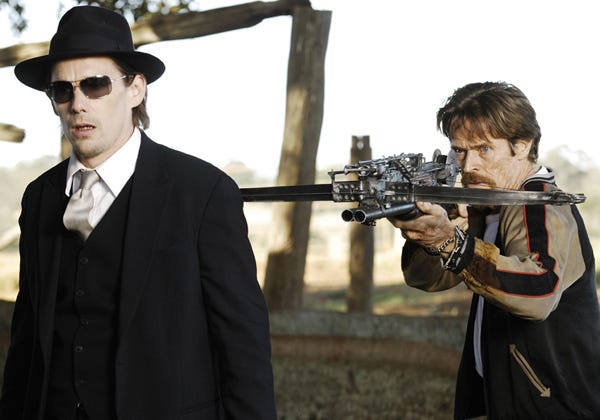Daybreakers

The prologue to “Daybreakers” defiantly stamps garlic cloves on “Twilight’s” forehead — a cute, sad little-girl vampire voluntarily sees the sun and turns to ash.
Yes, “Daybreakers” features non-sparkling, non-sulking, honest-to-Satan vampires — practically a planetful after an outbreak of vampirism takes hold of all but a few humans, with the remainder hunted by armies and harvested for blood.
Although the Spierig Brothers’ bloodsucker B-movie isn’t as polished as the first two “Blade” films, it’s a major leap beyond “Undead,” their zombies-in-the-Outback debut. Wisely, they don’t rework vampire lore for romance, but tweak it for nasty twists and invite inside several slices of social, political and military commentary.
A decade after the global infection, blood supplies are perilously low, and no one wants to become a “subsider” — starved vampires who feed off their own poisonous blood before perishing.
At the Bromley/Marks pharmaceutical company, efforts to create a blood substitute are overseen by chief hematologist Edward Dalton (Ethan Hawke, introduced in a fashion that can only be termed Amish noir). But a test of Dalton’s latest batch suffers a particularly eruptive failure, which worries oily CEO Charles Bromley (Sam Neill, exuding suit-and-tie menace a la “The Matrix’s” Hugo Weaving).
After a human-resistance group contacts him, Dalton meets Lionel “Elvis” Cormac (Willem Dafoe) — a motorhead mechanic and former vampire who has turned human. A reluctant vampire turned by his own brother (Michael Dorman), Dalton tries to replicate Cormac’s shift back to humanism as Bromley’s goons pursue them.
Clearly inspired by the dreary look of Alex Proyas’ “Dark City,” the Spierigs (who also co-supervised visual effects) dazzlingly establish a world run at night by necessity, with a touch of “Robocop’s” savage propaganda humor.
Vampires drive vehicles modified for daytime driving and live under low-wattage lighting. Subway stations are slathered with Uncle Sam posters encouraging vampires to enlist and round up remaining humans. And especially in the second half, the Spierigs start sharpening pointy allegorical stakes and spilling potent oil-market metaphors along with the blood.
Lest “Daybreakers” forget its promised cheap-thrill goods, the Spierigs toss in one memorably energetic car chase. And Dafoe adds another loon to his resume, nibbling more scenery than he chews — peeved that vampire armies would jack up his Mustang, using “Burning Love’s” lyrics as foreshadowing and crafting one eloquently naughty simile about how humans feel in a world full of vampires.
“Daybreakers” would be better without Hawke doing his best Edward Burns — those “enraged” yells sound about as tough as a 12-year-old tackling puberty. And it all but stops cold during its crimson-soaked climax, where villains are manufactured out of nowhere and one particular plot turn turns into a Python-esque parody of itself.
But as a vigorous reclamation of what vampire-genre movies should be, “Daybreakers” is, oh, positive.


